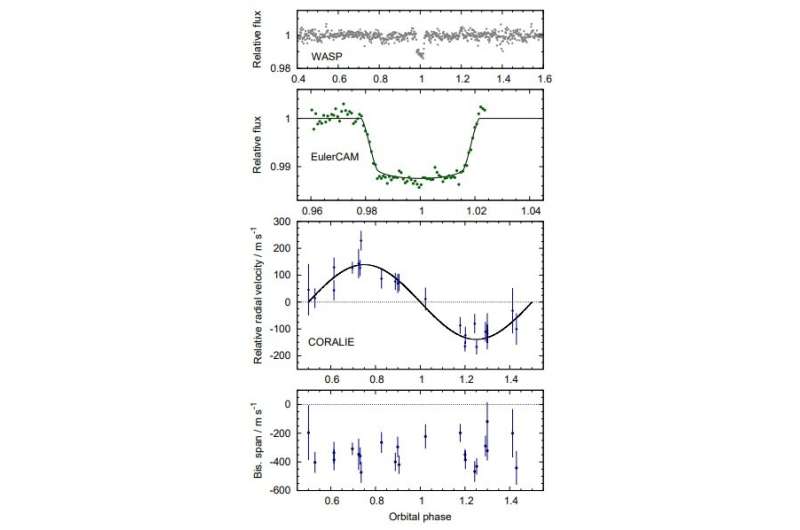August 5, 2019 report
Four new 'hot Jupiters' discovered

Astronomers report the detection of four new "hot Jupiter" exoplanets as part of the WASP-south survey. The newfound alien worlds received designations: WASP-178b, WASP-184b, WASP-185b and WASP-192b. The discovery is detailed in a paper published July 26 on arXiv.org.
The detection was made by a team of researchers led by Coel Hellier of the Keele University, U.K. They used the WASP-South telescope at the South African Astronomical Observatory (SAAO) in South Africa. WASP (Wide Angle Search for Planets) is an international consortium conducting an ultra-wide angle search for exoplanets using the transit photometry method.
The astronomers identified transit signals in the light curves of four stars during an observational campaign taking place between 2006 and 2014. The planetary nature of these signals was later confirmed by follow-up observations at the Euler-Swiss telescope and the TRAnsiting Planets and PlanetesImals Small Telescope (TRAPPIST), both located in Chile.
"We report on four new transiting hot Jupiters discovered by the WASP-South survey. (…) The WASP-South photometry was accumulated into multi-year lightcurves for every cataloged star, which were then searched for transits using automated routines followed by human vetting of the search outputs. Planet candidates were then listed for follow-up observations by the TRAPPIST-South 0.6-m robotic photometer and the Euler/CORALIE spectrograph," the astronomers wrote in the paper.
All four newly identified alien worlds were classified as "hot Jupiters," as they are similar in characteristics to the solar system's biggest planet, with orbital periods of less than 10 days. Such exoplanets have high surface temperatures, as they orbit their parent stars very closely.
Located about 1,360 light years away from the Earth, WASP-178b was even classified as an "ultra-hot Jupiter," given that its day-side temperature exceeds 2,200 K. In the case of this planet, this parameter was calculated to be around 2,470 K, what makes it one of the hottest exoplanets of this type known to date.
Observations show that WASP-178b has a radius approximately 81 percent larger than that of Jupiter, while its mass is around 1.66 Jupiter masses. It takes the planet about 3.34 days to fully orbit its host, WASP-178b (a star of spectral type A1V, around twice as massive as the sun, with an effective temperature of 9,350 K), at a distance of some 0.056 AU from it. The parent star turns out to be the second-hottest transit host so far identified.
WASP-184b is the least massive planet out of the newly discovered quartet—with a mass of only 0.57 Jupiter masses, however, around 33 larger than Jupiter. The alien world was found to be transiting a G0 host, every 5.18 days, separated by approximately 0.063 from the star. The planet's temperature was calculated to be around 1,480 K. The host is about 65 percent larger and 23 percent more massive than the sun, located nearly 2,100 light years away.
WASP-185b has a radius of about 1.25 Jupiter radii and is approximately as massive as Jupiter. However, although its mass and radius are typical for "hot Jupiters," it's orbital parameters are rare among such planets. The observations indicate that this extrasolar world has an eccentric orbit (with an eccentricity of about 0.24) and a relatively long orbital period of about 9.4 days. The planet's mean distance to the host is around 0.09 AU and its temperature was calculated to be 1,160 K. With an effective temperature of 5,900 K, the parent star is of spectral type G0 and has a mass of approximately 1.12 solar masses. The system is located about 900 light years away.
WASP-192b is the most massive exoplanet reported in the paper. With a radius of about 1.23 Jupiter radii, it is around 2.3 times more massive than Jupiter. The planet orbits WASP-192 (a moderately evolved G0 star with a mass of approximately 1.09 solar masses and an effective temperature of 5,900 K) every 2.88 days, at a distance of some 0.04 AU from it. The planet's temperature was measured to be about 1,620 K. The planetary system is approximately 1,600 light years away from the Earth.
More information: C. Hellier, et al. WASP-South hot Jupiters: WASP-178b, WASP-184b, WASP-185b & WASP-192b arXiv:1907.11667v1 [astro-ph.EP]: arxiv.org/abs/1907.11667
© 2019 Science X Network





















